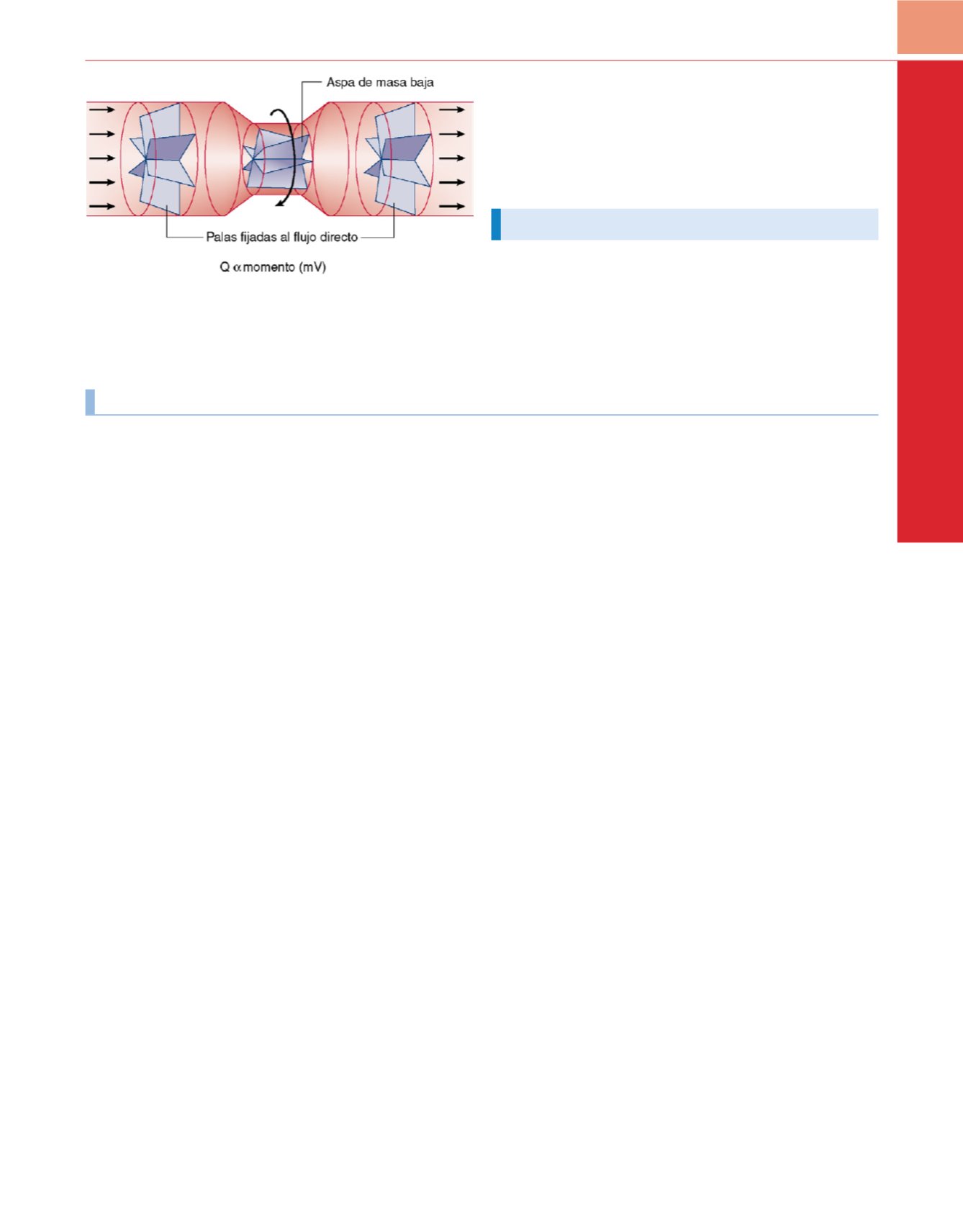

© ELSEVIER. Fotocopiar sin autorización es un delito
debido a su presencia. Un espirómetro de aspas rotativo puede
reducir el flujo de gas a tasas de flujo altas debido a la fricción
interna. Existen varios métodos para medir la velocidad del fluido
o el flujo que dependen de una medida de presión (el tubo de Pitot,
el tubo de Venturi, el medidor del flujo del orificio); por tanto, la
medida del flujo no es más exacta que la medida de la presión.
Conclusión
Se están desarrollando nuevos monitores casi continuamente, pero
en raras ocasiones se descubren nuevos principios físicos. La física
es un esfuerzo constante para comprender, simplificar y predecir
la conducta del universo en términos cuantitativos. En los capítulos
siguientes se hará referencia varias veces a los términos y principios
que se han analizado aquí.
Bibliografía
1. DeGowin EL, DeGowin RL: Bedside Diagnostic Exa-
mination, 5th ed. New York, Macmillan, 1987.
2. Bland JM, Altman DG: Statistical methods for asses-
sing agreement between two methods of clinical
measurement. Lancet 1:307-310, 1986.
3. Beecher HK: The first anesthetic record (Cushing and
Codman). Surg Gynecol Obstet 71:689-692, 1940.
4. Cushing H: Technical methods of performing certain
operations. Surg Gynecol Obstet 6:237-246, 1908.
5. Sykes MK,Vickers MD, Hull CJ: Principles of Measu-
rement and Monitoring in Anaesthesia and Intensive
Care, 3rd ed. Boston, Blackwell, 1991.
6. Dorje P, Tremper K: Systolic pressure variation: A
dynamic measure of the adequacy of intravascular
volume. Semin Anesth Periop Med Pain 24:147-153,
2005.
7. Michard F: Changes in arterial pressure during
mechanical ventilation. Anesthesiology 103:419-428,
2005.
8. Quill TJ: Blood pressure monitoring. I
n
Ehrenqerth
J (ed): Anesthesia Equipment Principles and Applica-
tions. St. Louis, Mosby-Year Book, 1993.
9. O’Brien E: Has conventional sphygmomanometry
ended with the banning of mercury? Blood Press
Monit 7:37-40, 2002.
10. Ireland J: In praise of mercury sphygmomanometers:
Electronic readings of blood pressure seem to be
higher than readings obtained with mercury
sphygmomanometers. BMJ 322:1249, 2001.
11. Resnick R, Halliday D: Physics for Students of Science
and Engineering. New York, John Wiley & Sons,
1960.
12. Rappaport MB, Sprague H: Physiologic and physical
laws that govern auscultation, and their clinical appli-
cations. Am Heart J 21:257-318, 1941.
13. Cahalan MK, Litt L, Botvinick EH, Schiller NB:
Advances in noninvasive cardiovascular imaging:
Implications for the anesthesiologist. Anesthesiology
66:356-372, 1987.
14. Clements FM, de Bruijn NP: Perioperative evaluation
of regional wall motion by transesophageal two-
dimensional echocardiography.Anesth Analg 66:249-
261, 1987.
15. Wong D, Tremper K, Stemmer E, et al: Noninvasive
cardiac output: Simultaneous comparison of different
methods with thermodilution. Anesthesiology
72:784-792, 1990.
16. Gravenstein JS, Paulus JS, Hayes TJ: Capnography in
Clinical Practice. Boston, Butterworths, 1989.
17. Severinghaus JW, Astrup PB: History of blood gas
analysis. Int Anesthesiol Clin 25:1-224, 1987.
18. Tremper KK, Barker SJ: Pulse oximetry. Anesthesio-
logy 70:98-108, 1989.
19. Barker SJ, Tremper KK, Hyatt J: Effects of methemo-
globinemia on pulse oximetry and mixed venous
oximetry. Anesthesiology 70:112-117, 1989.
20. Pologe JA: Pulse oximetry: Technical aspects of
machine design. Int Anesthesiol Clin 25:137-153,
1987.
21. Dumas C, Wahr JA, Tremper KK: Clinical evaluation
of a prototype motion artifact resistant pulse oximeter
in the recovery room. Anesth Analg 83:269-272,
1996.
22. Barker SJ, Shah NK: The effects of motion on the
performance of pulse oximeters in volunteers
(revised publication). Anesthesiology 86:101-108,
1997.
23. Barker S, Curry J, Redord D, Morgan S: Measurement
of COHb and MetHb by pulse oximetry: A human
volunteer study. Anesthesiology: 892-897, 2006.
24. Wahr JA, Tremper KK, Samra S, Delpy DT: Near-
infrared spectroscopy: Theory and applications. J
Cardiothorac Vasc Anesth 10:406-418, 1996.
25. Budavari S, O’Neil MJ, Smith A, Heckelman P: The
Merck Index, 11th ed. Rahway, NJ, Merck, 1989.
26. Moxham JP, Lee PK: Broken glass mercury thermo-
meter: A difficult airway foreign body. Otolaryngol
Head Neck Surg 127:339-341, 2002.
27. Shinozaki T, Deane R, Perkins FM: Infrared tympanic
thermometer: Evaluation of a new clinical thermome-
ter. Crit Care Med 16:148-150, 1988.
28. Pransky SM: The impact of technique and conditions
of the tympanic membrane upon infrared tympanic
thermometry. Clin Pediatr (Phila) 30:50-52, 1991.
29. Terndrup TE, Rajk J: Impact of operator technique
and device on infrared emission detection tympanic
thermometry. J Emerg Med 10:683-687, 1992.
30. Chamberlain JM, Terndrup TE: New light on ear
thermometer readings. Contemp Pediatr 11:66-76,
1994.
31. Vaughn MS, Cork RC, Vaughn RW: Inaccuracy of
liquid crystal thermometry to identify core tempera-
ture trends in postoperative adults. Anesth Analg
61(3)284-287, 1982.
32. Ikeda T, Sessler DI, Marder D, Xiong J: Influence of
thermoregulatory vasomotion and ambient tempera-
ture variation on the accuracy of core-temperature
estimates by cutaneous liquid-crystal thermometers.
Anesthesiology 86:603-612, 1997.
33. Cicman JH, Gotzon J, Himmelwright C, et al: Opera-
ting Principles of Narkomed Anesthesia Systems, 2nd
ed. Telford, PA, WE Andrews, 1998.
34. Q2 CCO/SvO2 Monitoring SystemOperating Manual
[computer program]. North Chicago, Abbott Labora-
tories, 1998.
Principios fundamentales de los instrumentos de monitorización
987
28
Sección III
Control de la anestesia
Figura 28-37
Espirómetro de aspas. Los gases en movimiento contienen
energía cinética. Esto puede demostrarse por un «molino de viento» girando
en la corriente de aire.
(Adaptada de Ehrenwerth J, Eisenkraft J:
Anesthesia
Equipment: Principles and Applications
. St. Louis, Mosby-Year Book, 1993.)









